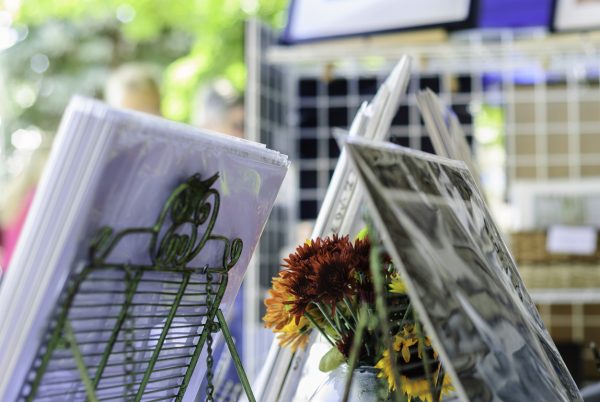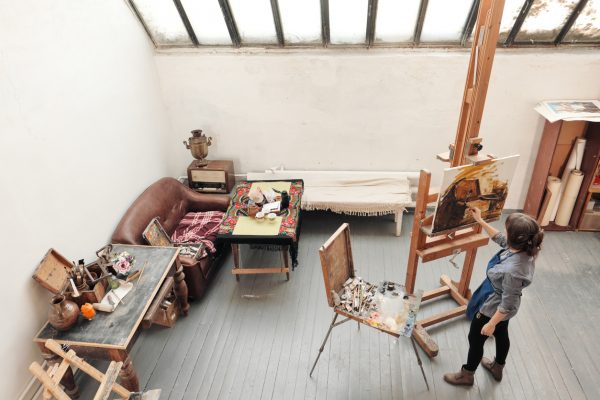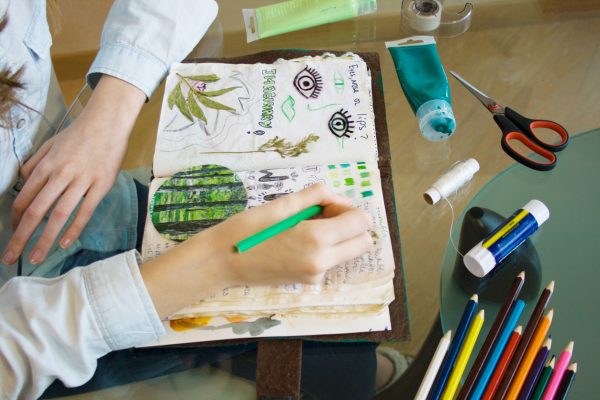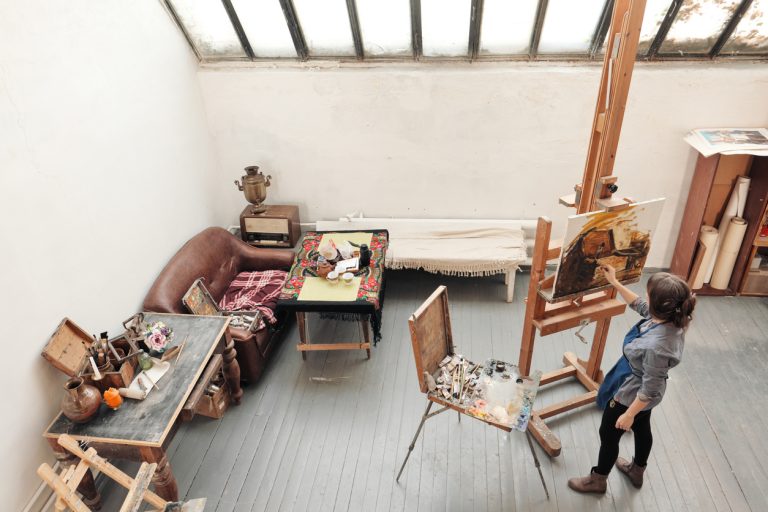All creative people at some point or another suffer from ‘artists’ block’, a cycle of frustration generated through a lack of inspiration and a lack of self-belief. These two creative enemies perpetuate one another until the artist in question reaches a point of despair, unable to move forward and create new work. But have no fear, there is a way out of creative block! In fact, there are many ways. Like anything, it takes perseverance, but sometimes all we are looking for is one tiny spark to open up a whole world of possibilities. So, let’s get out of the rut…
Step 1. Stop thinking about it

Worrying over the creative block is never going to get you anywhere. If you’ve been stewing away at the studio for hours, put your pen/pencil/clay down, get up and leave the space. Do anything different – walk the dog, run some errands, meet a friend. The important part is to get outside, to feel nature and the elements, and remind yourself that you’re a human, not a painting/drawing/sculpting robot.
Step 2. Concentrate on your physical health

When we are searching desperately for the next idea, we may well turn to the coffee and sugar that promise ‘focus’ and quick fixes for energy levels, which ultimately lead to a crash and will make us feel a lot less creative. Instead, take some time to go for a long walk, run, swimming, or your favourite exercise, and eat lots of nutritious protein, fruit and veg. Feeling great in your body can go a long way to feeling good in the mind.
Step 3. Open your mind

Go somewhere you’d never normally go. Maybe there’s a local museum you’ve never thought to visit? Just think what might be hiding in there waiting to inspire you. Try going to a book shop and immersing yourself in a topic at random for a couple of hours. Other good options are galleries, libraries, gardens, car-boot sales, markets, vintage fairs… the list goes on. Any public place that offers potential inspiration – go forth and seek it out. Or, if you aren’t able to get anywhere quickly, why not start by browsing Pinterest – it’s a fantastic source of creative inspiration. You could try searching random terms or just see what pops up in the recommended feed, or browse ArtWeb’s boards ;). The world has never been richer in terms of the information so instantly available to you – so get out there and grab hold of it!
Step 4. Rearrange your space.

When you’re feeling ready to re-enter your creative space, try looking at it with new eyes. Do you really need that old shopping list on the wall? What about that out-of-date poster for an upcoming exhibition – did you go, did you like it? If not, get rid! It’s not just what’s on your wall though, try thinking of a completely new layout, and have a proper sort out of your creative tools and materials. If being organised is really important to you, then take this time to re-arrange and sort your brushes, pens, fabrics and paints. Of course, redesigning your studio can require inspiration in itself, which is why it’s so good in this process as it enables you to focus your creativity on an entirely different, yet useful area. If you’re not sure where to start, try getting some ideas from famous creative spaces, or search pinterest for visual ideas.
Step 5. Try something totally new

When you’ve decided to get back into the creative process, don’t go straight back to where you were struggling before. Start by trying something entirely new, whether it’s a new medium or a new subject area. Make sure it’s something you’ve never tried before, get out of your comfort zone and be open to surprising yourself. Remember that it’s important just to continue making, and if it doesn’t work, it doesn’t matter! When you start to think of your practice as exactly that, practice, the act of making without a plan or the need for an outcome can be extremely freeing, rewarding and enriching. Think of it like playtime and you’ll start to have a lot more fun!
Step 6. New strategies
At some point you may well need to re-approach the thing that got you so stuck in the first place. Maybe you were trying to think of an idea for an upcoming exhibition, or deciding how to approach a commission. If so, these aren’t things that can simply go away because you’re stuck. All of the above will help, but if you’re still feeling the block, maybe it’s time for some lateral thinking… This is a bit off-piste but something that’s helpful to many artists – Brian Eno and Peter Schmidt’s ‘Oblique Strategies’. Originally a card deck with suggestive statements of how to approach a creative problem, these can now be found online at http://www.oblicard.com/. The random selections consist of various ambiguous strategies such as: ‘Use an old idea’, ‘State the problem in words as clearly as possible’, and ‘Only one element of each kind’. Some of them are specific to music, but most are for useful for general creative thinking… it might seem like just a bit of fun but it could also send you off in an exciting new direction.
Step 7. Talk it out

Bringing a collaborator in can instantly change how you see the work. By collaborator, we don’t necessarily mean 2 artists holding brushes to one canvas (although this could be a great experiment!), but more in terms of conversation and critique. If you’re renting a studio space, you’ll likely be surrounded by other artists, however it can often still be fairly solitary. Making the effort to invite some feedback on your work may seem daunting, but it can really help you understand what’s working and what isn’t, as well as giving you some ideas for how to direct it. If you don’t have a shared studio space, why not invite some fellow artist friends around for a mini critique at your house. Creating peer-mentoring groups is so important to artists, as we discussed in this article a while ago. They keep up your confidence and spur you on – conversation is key to motivation!
Step 8. Try some of these quick-fix strategies for creative block crisis
- Close your eyes and describe what you see (recording it if possible)
- Take a piece of work you deem a success, and stand so close to it that you can no longer focus on it. Then back away very slowly and begin describe what you see, what you like, what it makes you think of… let your thoughts wander. Start with literal explanations if you’re not sure, and see where it takes you.
- Restrict yourself. If your block is based on decision making, then taking out the option to decide can be freeing. Write yourself a short brief such as ‘draw the view from my studio in 5 minutes using only blue pens’, or ‘create a self-portrait without using a mirror and using only watercolour paint’. Even if these tasks seem irrelevant they can be useful in just getting your brain working, and by giving yourself very quick time limits you won’t end up spending hours on them.
- Read yourself to inspiration. Books can take your mind to completely new places you never knew existed… perhaps not so quick-fix but it definitely helps long-term.
- See your work from a different angle – literally. Turn it upside-down, put it on the floor, or place it next to something in a different room. Also try photographing it and uploading it to your website – it’s amazing what this process can do to how you think about the work, once the potential for it to go public is implied.
- Imagine you’re someone else, anyone – a teacher, a fashion designer, your partner… how might they approach this problem?
- Offer your help to someone else. Perhaps another artist looking for feedback, or someone who wants to learn a skill you have. Sometimes it’s fascinating to learn about what we actually already know, through the act of teaching.
- Pick random things and force yourself to make links. All it takes to get those synapses firing is a little connection, so try some fun ways to initiate new ideas. Grab the nearest three books, turn them to random pages, and point at a word with your eyes closed. See what three words you have and use them as a starting point for making… you never know where it could lead.
We hope these tips have helped you begin to see the other side of creative block. The important thing to remember is that there is another side, it’s just about finding the right route through – these are just some tools with which to begin doing so. Good luck!
Got any tips you’d like to share? Feel free to leave a comment below.







